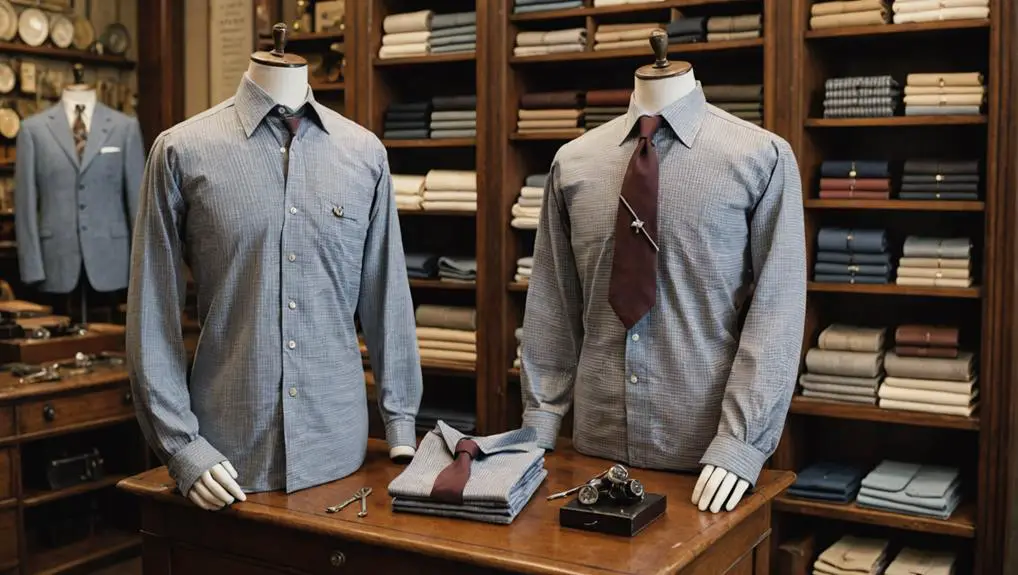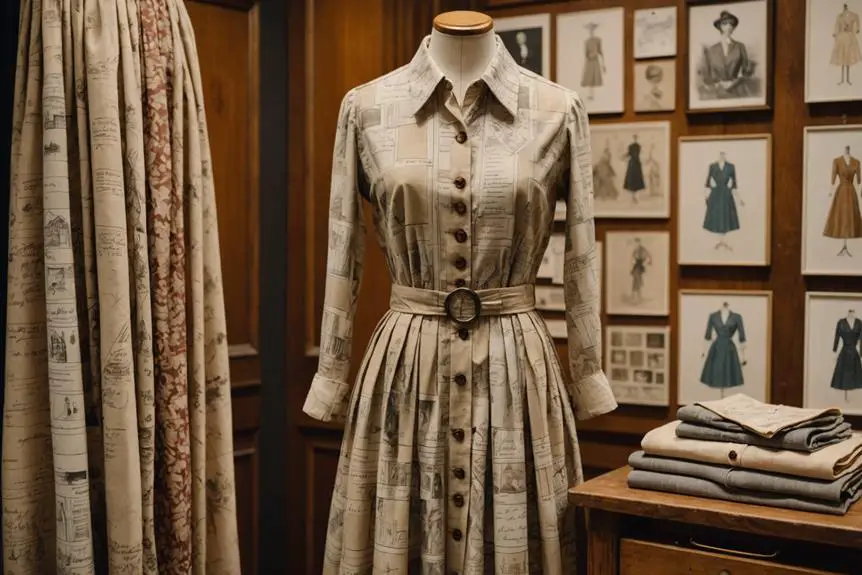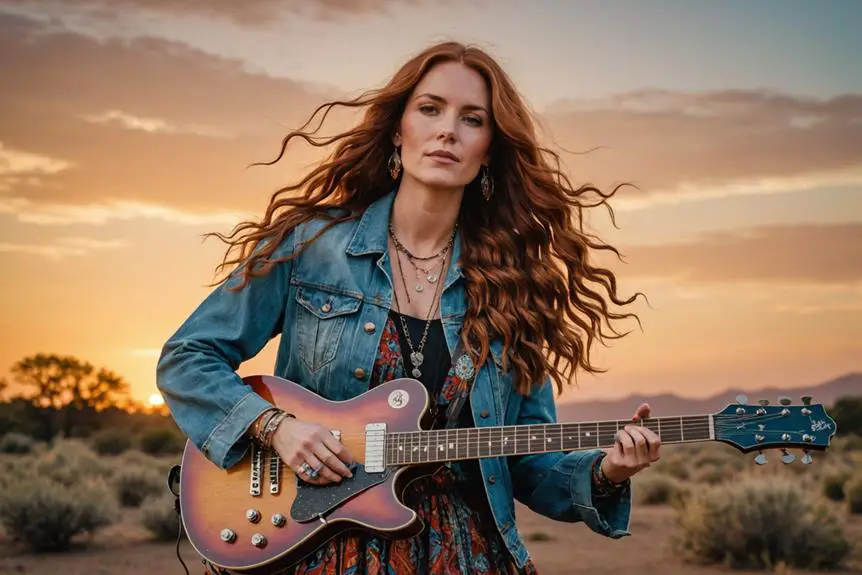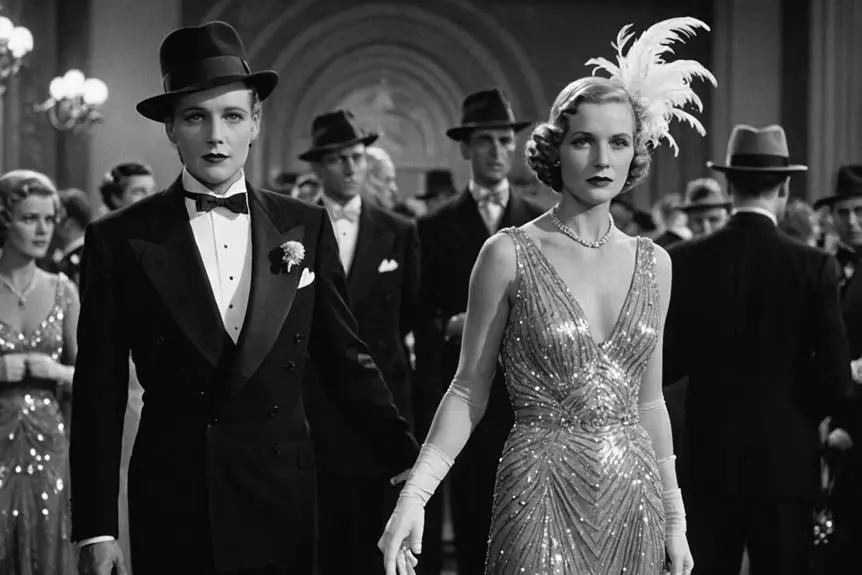In the 1930s, men's dress shirts shifted towards a more relaxed aesthetic, moving away from stiff detachable collars to softer spearpoint styles. You'd find popular patterns like thin vertical stripes and windowpane designs in saturated colors such as burgundy and blue. Fabrics like cotton broadcloth and tropical Oxford cloth offered durability while reflecting a preference for practical elegance amid the Great Depression. Casual shirts, featuring bold colors and lighter fabrics, began to emerge, showcasing comfort as essential. This era's fashion tells a compelling story about adapting to social changes, and there's more to uncover about its influences and designs.
Overview of 1930s Shirt Styles
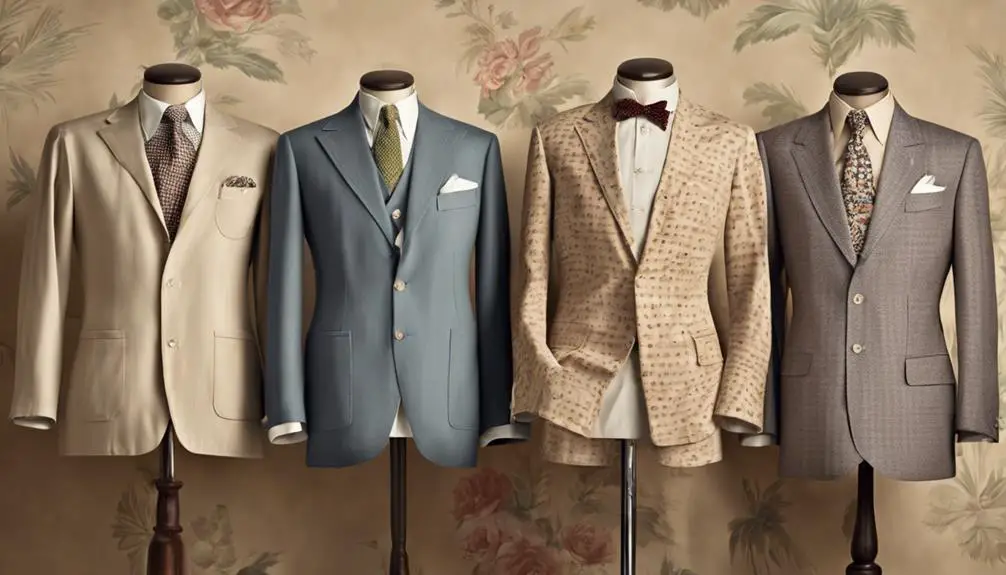
In the 1930s, men's dress shirts underwent a remarkable evolution that mirrored broader societal changes. The era embraced a vintage aesthetic characterized by new styles and innovative designs. You'd notice the shift from stiff, detachable collars to softer, attached spearpoint collars, which were typically 3 to 5 inches long. This change represented a move toward comfort and a more relaxed yet polished appearance. During this time, understanding the historical context of vintage clothing labels became essential for enthusiasts, as it provided insight into the craftsmanship and design nuances of the period.
Dress shirts of this decade often featured thin vertical stripes, windowpane patterns, and small checks, with colors like saturated green, mustard, and pastel shades capturing attention. The choice of fabrics was equally significant, with cotton broadcloth, crinkle cotton, and tropical Oxford cloth proving popular for their durability and comfort.
Typical designs included single-button cuffs and double French cuffs, providing versatility for both casual and formal occasions. The addition of stitched-in flaps on chest pockets further enhanced functionality while maintaining a stylish profile. As the decade progressed, the introduction of thin silk striped dress shirts marked a shift towards luxurious materials, reflecting changing tastes in men's fashion. These elements combined to define a distinctive style that left a lasting impact on dress shirt design.
Popular Fabrics and Patterns
Frequent experimentation with fabrics and patterns defined men's dress shirts in the 1930s, reflecting the era's evolving tastes and social dynamics. The most common materials included cotton broadcloth and tropical Oxford cloth, prized for their durability and comfort. Crinkle cotton also gained popularity, contributing to the diverse fabric landscape of the decade.
Patterns were subtle yet striking, with thin vertical stripes dominating the scene. These designs conveyed a sense of understated elegance, aligning with the period's focus on subtle sophistication. As the decade progressed, thin silk striped dress shirts emerged, offering a luxurious option for formal occasions.
Color choices were varied, with saturated hues like burgundy, blue, and green appealing to more daring styles, while softer pastel tones such as yellow and rose-pink catered to those preferring a gentler palette. Functional details like single button cuffs and double French cuffs enhanced the overall aesthetic, merging practicality with style. Many shirts featured a single chest pocket with a stitched flap, adding an extra layer of refinement. This combination of fabrics and patterns not only shaped the 1930s wardrobe but also set a precedent for future shirt styles.
Evolution of Shirt Collars
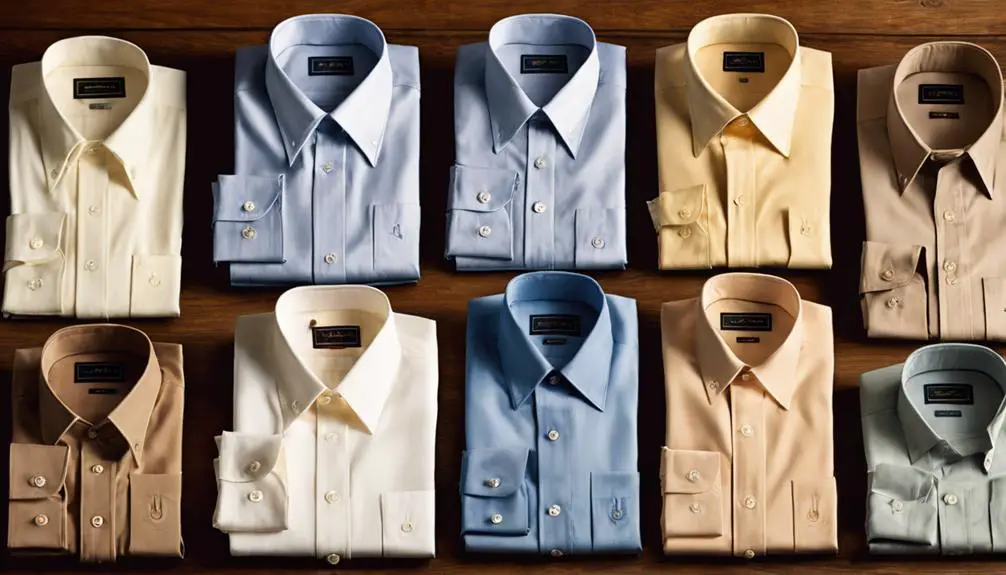
The evolution of shirt collars in the 1930s illustrates a significant shift in men's fashion towards comfort and practicality. During this decade, you'd notice a departure from the rigid, detachable collars that had dominated previous styles. Instead, the soft attached spearpoint collar emerged, typically measuring between 3 to 5 inches, offering a more relaxed aesthetic. This transformation reflected a growing desire for comfort in menswear.
Hollywood played a pivotal role in shaping preferences, with stars like Clark Gable popularizing the California collar alongside the wide Windsor collar. This marked a move towards a more casual yet sophisticated look. The introduction of permanently fused collars was another game-changer, as they maintained their shape and resisted curling, enhancing the overall wearability of dress shirts.
Types of Dress Shirts
During the 1930s, men's dress shirts branched out into various styles, each offering unique features suited to different occasions and preferences. The fabrics used, such as cotton broadcloth and tropical Oxford cloth, provided a blend of comfort and elegance, making these shirts a staple in every man's wardrobe. You'd often see popular prints like thin vertical stripes and windowpane patterns, with colors ranging from saturated green to pastel yellow.
Design elements became more sophisticated, with many shirts featuring double French cuffs that allowed for cufflinks, adding a touch of class. A single chest pocket, often with a stitched-in flap, provided functionality without sacrificing style. As the decade progressed, the introduction of thin silk striped dress shirts showcased luxurious fabrics and vibrant hues, appealing to those seeking refinement.
Collar styles also evolved, moving from stiff, detachable collars to softer, attached spearpoint collars, mirroring the era's fashion shift. Overall, the 1930s dress shirts reflect a time of innovation, where each type catered to the modern man's desire for both style and practicality.
Casual Shirt Trends
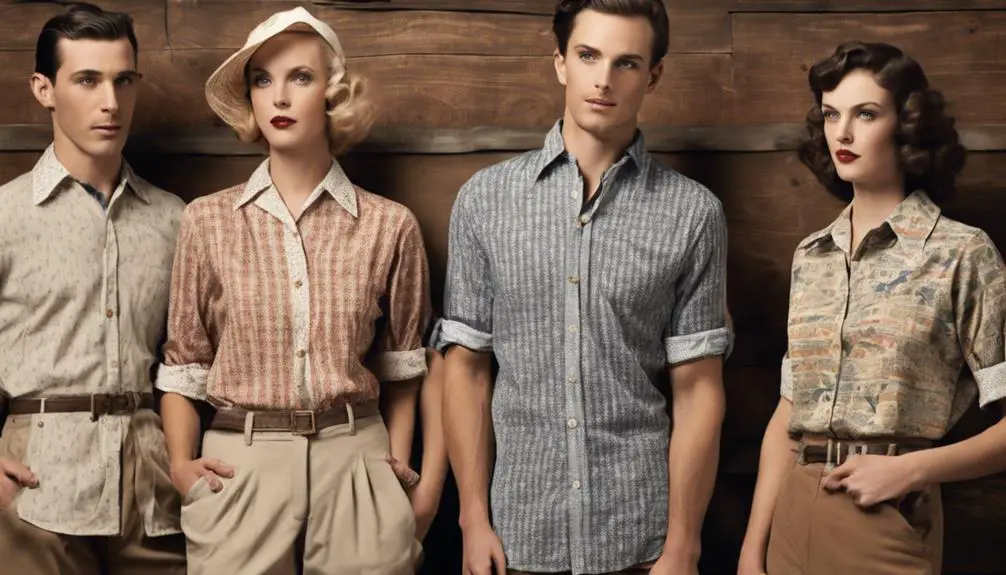
Casual shirt trends in the 1930s marked a significant departure from the rigid styles of formal wear, embracing comfort and versatility. During this decade, polo shirts emerged as popular casual wear, characterized by their short sleeves and knit fabrics, perfect for sports and leisure activities. You'd notice that casual shirts were often crafted from vibrant cotton materials, showcasing bold colors and patterns such as stripes and checks, reflecting a cultural shift towards more relaxed attire.
Denim shirts gained traction, becoming staples for workwear and casual outings, emphasizing both comfort and durability. Flannel shirts also became essential, providing warmth and a laid-back vibe. As the decade progressed, knit t-shirts rose in popularity, offering a versatile option for various casual engagements and sporting events.
One distinct feature of these casual shirts was the open collar design, which contributed to a relaxed fit that contrasted sharply with the structured styles of formal dress shirts of the era. This evolution in casual wear not only mirrored changing social norms but also paved the way for more comfortable, expressive clothing choices in men's fashion.
Special Features and Details
In the domain of men's dress shirts in the 1930s, various special features and details set these garments apart from their predecessors. One notable trend was the introduction of thin vertical stripes, windowpane patterns, and small checks, which added texture and visual interest. You'd often find colors like saturated green, blue, and burgundy dominating the fabric choices, enhancing the overall appeal.
Fabrics such as cotton broadcloth, crinkle cotton, and tropical oxford cloth were popular, with the late decade seeing a rise in thin silk-striped options. The design of these dress shirts also evolved considerably. You'd encounter features like single button cuffs, and double French cuffs, which allowed for a sophisticated touch, while a single chest pocket with a stitched-in flap provided practicality.
Perhaps one of the most notable shifts was the change from stiff, detachable collars to soft, attached spearpoint collars. This alteration not only improved comfort but also marked a style evolution. By the late 1930s, permanently fused collars gained popularity, maintaining their shape and eliminating the curling that often plagued earlier designs, making these dress shirts both stylish and functional.
Cultural Influences on Fashion
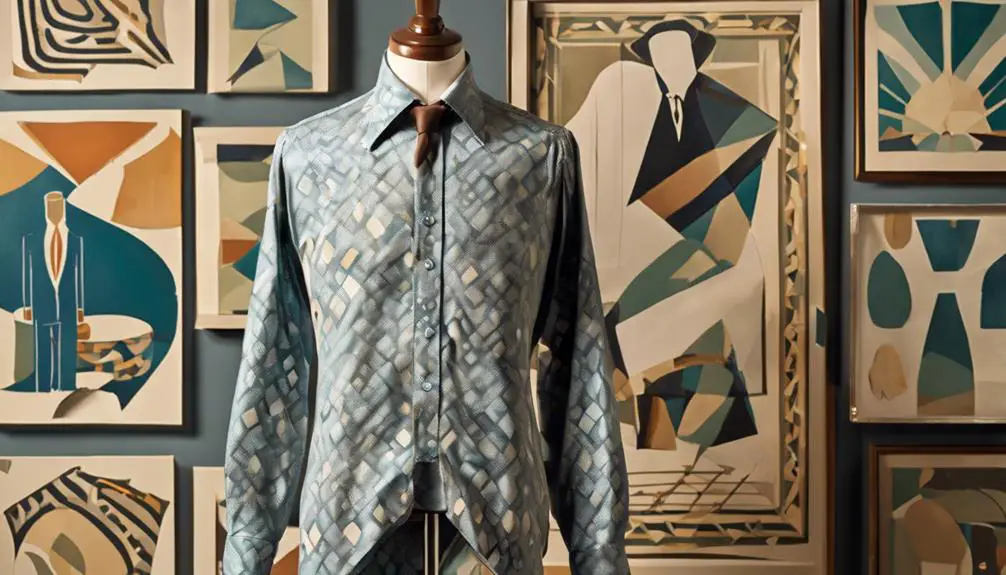
The 1930s ushered in a transformative period in men's fashion, where comfort and functionality took center stage, largely influenced by societal changes and economic realities. As leisure activities gained popularity, a cultural shift emerged, encouraging men to favor practicality in their dress shirts. The Great Depression prompted many to choose simpler designs that emphasized clean lines and avoided extravagance, reflecting a newfound appreciation for understated elegance.
Hollywood stars played a pivotal role in shaping these trends, with their casual styles often emulated by the masses. Open collars and colorful patterns became prominent, signaling a departure from strictly formal attire. This shift mirrored broader societal attitudes towards relaxation and leisure, allowing men to express individuality while remaining stylish.
Moreover, regional differences in clothing styles emerged across the U.S. and Europe, showcasing diverse cultural influences. Variations in fabrics and patterns for dress shirts reflected local preferences and lifestyles, demonstrating how men's fashion was not only a reflection of individual choice but also of collective cultural identities. Ultimately, the 1930s marked a significant period of evolution in men's fashion, where comfort and expression became essential components of dress shirts.
Economic Impact on Styles
While the economic challenges of the Great Depression shaped many aspects of daily life, they also profoundly influenced men's dress shirt styles during the 1930s. With financial constraints tightening their choices, many men turned to older, patched clothing, leading to a shift toward more practical and versatile dress shirts. The focus shifted to durable, affordable options, particularly in cotton, as luxurious fabrics became a rarity.
Consider these key shifts in style:
- The rise of collarless designs that required less fabric and tailoring.
- An emphasis on muted colors and simpler patterns, reflecting a more subdued aesthetic.
- A prioritization of quality over quantity, with men seeking well-made shirts that could endure regular wear.
These changes resulted in shirts that were not just functional, but also maintained a respectable appearance. The need for practicality and affordability redefined what it meant to dress well in the 1930s. As fashion became a luxury, men sought quality, durable shirts that would serve them well, allowing them to navigate the tumultuous economic landscape with a sense of dignity and style.
Tips for Collecting Vintage Shirts

As the practicality of the 1930s dress shirts gained prominence, collectors today have a unique opportunity to explore this fascinating era of men's fashion. When diving into vintage shirt collecting, focus on specific features like thin vertical stripes, single button cuffs, and detachable collars to guarantee authenticity.
| Aspect | Considerations |
|---|---|
| Fabric | Look for cotton broadcloth or silk. |
| Sizing | Check measurements—vintage sizes differ from modern. |
| Condition | Favor well-preserved items; repairs can lower value. |
Quality craftsmanship is paramount, as it affects both appearance and durability. Original tags or labels indicating the era and manufacturer can enhance a shirt's desirability among collectors. As you sift through options, take your time evaluating each shirt's condition; minimal wear is more appealing.
Keep in mind that vintage dress shirts from the 1930s offer a glimpse into a bygone fashion era and can serve as timeless pieces in your wardrobe. By focusing on these elements, you'll build a collection that not only reflects the style of the past but also stands the test of time.
Frequently Asked Questions
What Did Popular Shirts Look Like in the 1930s?
In the 1930s, popular shirts featured thin vertical stripes and small checks in vibrant colors. You'd notice soft spearpoint collars and practical details like single button cuffs, reflecting a blend of style and comfort.
What Did Guys Wear in the 1930s?
In the 1930s, you'd wear tailored suits with wide lapels, often paired with patterned ties and polished leather shoes. Fabrics were luxurious, reflecting the era's elegance, while accessories like hats completed your sophisticated look.
What to Wear to a 1930S Party for Men?
For a 1930s party, you'll want a stylish shirt with vertical stripes or checks, a spearpoint collar, and high-waisted trousers. Don't forget your blazer and accessorize with a bow tie for an authentic look.
Did Men Wear Tank Tops in the 1930s?
You won't find many men wearing tank tops in the 1930s. Instead, they favored short-sleeved and polo shirts for casual wear, reserving sleeveless styles for specific activities like sports or labor, not everyday fashion.
